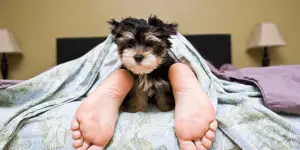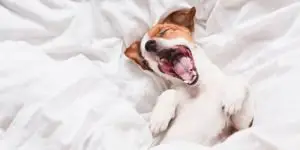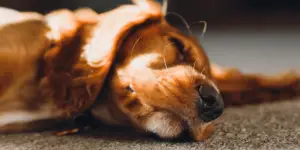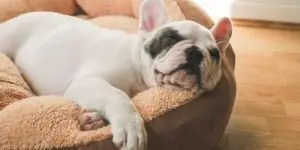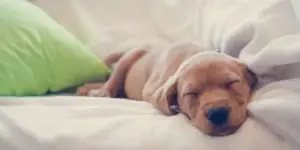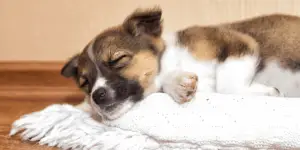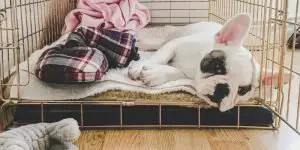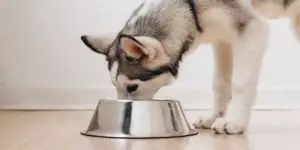
Why Do Puppies Twitch In Their Sleep?
- Written by Joshua Gordon
- Last updated
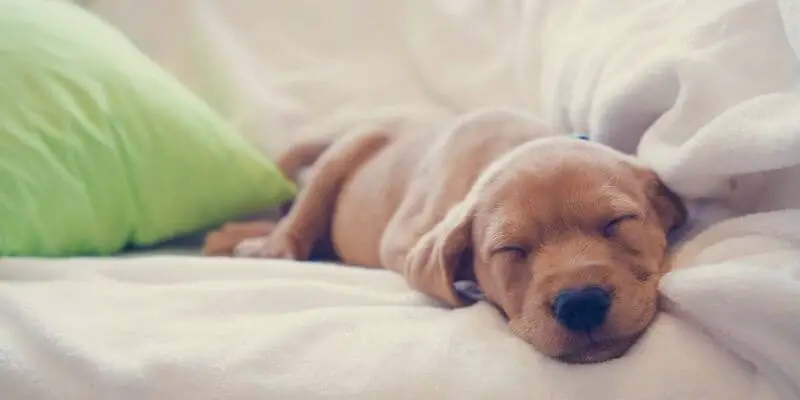
Key takeaways
- Light twitching is commonly a sign that your puppy is growing. Many dogs shake or jolt slightly in their sleep, especially during the REM stage. Twitching is also more common in puppies as they are still growing!
- Watch for signs of seizure. Twitching that is particularly violent and followed by symptoms like stiff limbs, peeing/pooping, foaming at the mouth, and unresponsiveness are signs of a seizure
In this article
Why do puppies twitch in their sleep?
A puppy twitching in their sleep can be worrying as it can be mistaken for a seizure for a first glance. However, most of the time, the occasional twitch here and there during a nap isn’t a cause for concern.
Many dogs shake or jolt slightly in their sleep, especially during the REM stage. Twitching is also more common in puppies as they are still growing!
That being said, twitching that is particularly violent and followed by symptoms like stiff limbs, peeing/pooping, foaming at the mouth, and unresponsiveness are signs of a seizure.
It’s important to know the difference between normal and abnormal twitching so you know when it’s time to call a vet.

Ask the Vet - Why is my puppy twitching in their sleep?
"Twitching, jerking and even a little paw paddling can be quite normal while a puppy sleeps. This is because they are dreaming and reacting to what they are dreaming about. You will know your puppy is not having a seizure as they can be woken up within a few seconds"
- Dr Linda Simon MVB MRCVS
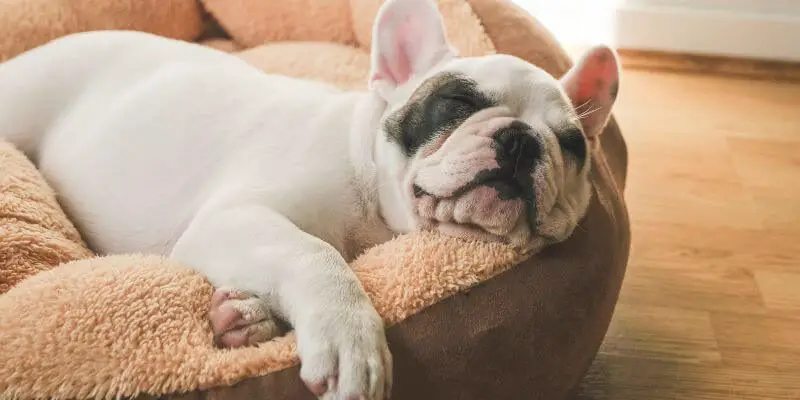
Watch: Puppy twitching explained
Seeing your puppy twitch in their sleep can be concerning, especially as it can be accompanied by kicking, whining, heavy or fast breathing, and rapid eye movement. However, in most cases, twitching is a completely normal sign of REM (Rapid Eye Movement) sleep – it isn’t usually something to be worried about.
Credit: Grunge
It’s a normal sign of REM sleep
Dogs have a similar sleep pattern to humans – they experience periods of peaceful, quiet sleep, as well as periods of rapid eye movement and jolting. Research has also shown that dogs dream and have nightmares, which are both more prevalent in the REM stage.
However, dogs go through sleep stages quicker than we do. Humans typically experience 4 to 5 sleep cycles, whereas dogs go through 20 or more! This makes twitching, vocalizing, and rapid eye movement during REM sleep a lot more common in dogs.
Additionally, puppies shake more frequently during sleep than adult dogs as they are trapped in the REM phase (when dreams tend to occur) for longer. That’s because puppies nap a lot longer (and deeper!) than adult dogs, particularly in the first few months of their lives.
In fact, puppies that are just 2 weeks old spend around 90% of their time asleep. The amount of sleep pups need gradually decreases with age, but even 6-month-old pooches sleep for around 16 to 18 hours a day.
Adults, on the other hand, sleep for between 8 to 13.5 hours each day, with the average being around 11 hours. Your puppy will normally enter the REM phase of sleep about 20 minutes after they’ve dozed off.
During this stage, your pooch’s muscles and eyelids will twitch, and they may also bark or whimper. The neurological system shuts down a large portion of your puppy’s motor functions while they’re asleep, though certain parts of their brain will still be active.
It’s thought that puppies twitch more than adults during sleep as their brains are undeveloped. Furthermore, puppies experience a lot of new smells, sights, sounds, etc, so they usually remain in REM sleep a bit longer than adults in order to process all these unfamiliar events.

It improves muscle tone
Another reason why puppies twitch in their sleep is that it exercises their muscles, which increases muscle tone and strength. Puppies between 5 to 7 days old are just starting to use their front legs to move.
However, their back legs are still very weak. It isn’t until around 2 weeks old that pups start using their back legs.
Muscle twitching during sleep serves a function in especially young puppies, helping strengthen the muscles in their legs so they can start leaving their whelping box and exploring.
Should I wake my dog up when they are twitching?
It’s best to leave your dog alone if they are twitching in their sleep unless they are in visible distress. Waking up a sleeping pup could result in an aggressive response, especially if they are woken up suddenly during the REM phase.
If you need to wake up your pup, do so slowly and gently. Softly call your puppy’s name so you don’t startle them.
Once awake, give your puppy some time to come around as they may be groggy. Make sure to use gentle movements and a loving tone to reassure your pooch, particularly if they were experiencing a nightmare.
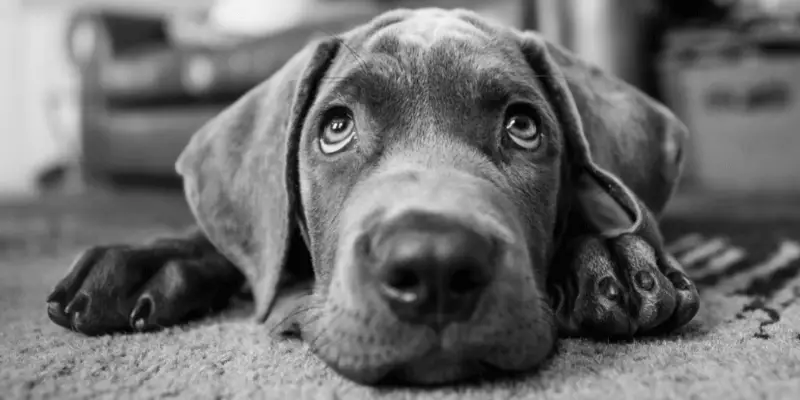
What’s the difference between twitching and a seizure when a puppy is sleeping?
A puppy twitching during a nap can sometimes be confused for a seizure if you’re unfamiliar with what they look like, but there are actually a few clear differences between the two.
Firstly, seizures cause your dog’s limbs to stiffen and become rigid. If your puppy is simply twitching as a result of dreaming, their limbs should feel flexible and soft.
Seizures also cause much more violent movement that lasts longer. It will be harder to wake up your puppy during a fit, and they may urinate or defecate. In addition, seizing dogs will usually be confused and may pant and drool after an episode.
If you’re concerned about your dog’s twitching during a nap, drop an object on the floor to make a loud noise to check their response. If they wake up, you’ll know they were only dreaming.
How to tell if a puppy is having a seizure while sleeping
A puppy that is having a seizure while asleep looks a lot different from a puppy that is only twitching during a dream. It’s important to be aware of the signs of seizures in dogs so you can be prepared if your pooch experiences one.
- Violent movements (often last for multiple minutes)
- Head pulled back
- Stiff, rigid limbs
- Defecation or urination
- Disorientation after an episode
- Drooling or panting after an episode
- Vomiting
- Foaming at the mouth
If your companion is suffering from a seizure, it’s crucial that you remain calm and protect them from injury. For instance, if your puppy is near the edge of a staircase or couch, move them onto the floor so they don’t fall during an episode.
Speak to your puppy in a calm, soothing voice and try to time the length of the seizure, as well as the frequency of episodes if it’s not the first time your puppy has had one. Although you may be worried and panicky, reassure your puppy as they come around – they will likely be very disoriented.
As seizures cause your dog’s body temperature to rapidly increase, it’s a good idea to place cold wet towels on their head, neck, and groin to help them cool down. Make sure your pooch has access to fresh water and some food as it’s common for dogs to be extremely thirsty or hungry after a seizure.#
However, don’t force your puppy to eat or drink if they don’t want to. Ice cubes can be a great way to hydrate your companion if they are reluctant to drink.
After your dog has had a seizure, they will probably be very tired, so leave them alone to rest if they need to. If it’s your dog’s first seizure or the episode lasted for more than 3 minutes, make an appointment with your vet straight away.
If your dog has multiple seizures within 24 hours (known as cluster seizures), this is especially a veterinary emergency.
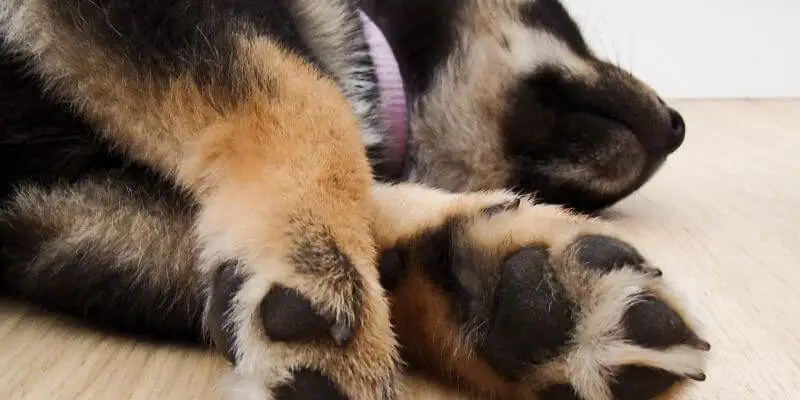
When to call a vet
If your puppy’s twitching is violent and lasts longer than a minute, especially if accompanied by other symptoms like defecation/urination, stiff limbs, foaming at the mouth, and a pulled-back head, it’s likely that they are experiencing a seizure.
Before your puppy has a seizure (known as the pre-ictal phase), they may be restless or nervous.
During a seizure (ictal phase), your puppy may have a “deer in the headlights” appearance, alongside aggressive muscle tremors and shaking.
After a seizure (post-ictal phase), your pooch will stop convulsing and likely be restless, disorientated, and salivating.
Book an appointment with your vet immediately, especially if your dog suffers from multiple seizures over a 24-hour timeframe. Seizures in dogs are always a cause for concern as they can be a sign of epilepsy, heatstroke, head trauma, or an underlying medical condition such as kidney disease and diabetes.
Some poisons can also cause seizures in dogs, so if you believe your puppy has ingested something they shouldn’t have, call your vet right away
What can help my dog sleep?
If your puppy is always raring to go and never wants to rest, there are a few things you can do to help them sleep and tire them out. A safe, comfortable area like a crate or soft basket will provide your pup with a warm place to retreat to when they’re sleepy.
Ample exercise and mental stimulation each day can also tucker your companion out so they drift off easily in the evening.
In addition, keeping things quiet and calm around an hour before your pooch’s bedtime will help them chill out and naturally feel tired. Be sure to take your puppy outside to relieve themselves just before bed too.
How much do puppies sleep?
Puppies spend a large portion of their day sleeping, especially under the age of 6 months. Most pups sleep for between 18 to 20 hours per day, though puppies over 6 months old will sleep slightly less at around 16 hours daily.
Final thoughts
In most cases, a puppy twitching in their sleep is nothing out of the ordinary – it’s usually a sign of healthy development and REM sleep.
However, muscle spasms and movements that are particularly violent and paired with symptoms like unresponsiveness, defecation/urination, disorientation, etc, are all signs of a seizure and should always be investigated by a vet.
Additionally, if you’re worried about your puppy’s twitching even if they don’t display the above behavior, it’s best to get your pooch checked out by a vet to be on the safe side.
References
- https://www.pdsa.org.uk/pet-help-and-advice/looking-after-your-pet/all-pets/seizures-and-epilepsy-in-pets?_$ja=tsid:|cid:1257363808|agid:61673263108|tid:kwd-299599258536|crid:410158989754|nw:g|rnd:17891616335966630749|dvc:c|adp:|mt:b|loc:1006674&gclid=Cj0KCQjwvLOTBhCJARIsACVldV0f5Jpk-8CMGkeOUn9xP1zRLXY0YDYTSbFBJnEvmtrrZ6TFE84UkIsaAlRVEALw_wcB
- https://www.hillspet.com/dog-care/behavior-appearance/dog-twitching-during-sleep#:~:text=If%20your%20dog%20is%20experiencing,Vomiting
- https://wagwalking.com/symptom/why-is-my-dog-jolting
- https://www.petmd.com/dog/general-health/why-do-dogs-twitch-their-sleep
- https://pethelpful.com/dogs/Why-do-Puppies-Twitch-in-Their-Sleephttps://www.akc.org/expert-advice/lifestyle/why-dog-twitch-in-sleep/
- https://www.petsradar.com/advice/dog-twitching-in-their-sleep
- https://pawleaks.com/dog-twitching-in-sleep/
- https://buddyrest.com/blogs/buddyblog/phases-of-dog-sleep-cycles#:~:text=Dogs%20have%20similar%20sleep%20cycles,notice%20deep%20and%20rhythmic%20breathing.
- https://www.akc.org/expert-advice/health/dreaming-vs-seizures-in-dogs/#:~:text=All%20dogs%20dream%2C%20and%20some,stiffer%2C%20with%20more%20violent%20movement.
- https://www.relievet.com/blogs/tips/dog-seizures-while-sleeping
- https://veterinaryemergencygroup.com/blog/dog-seizures/

Written by: Joshua Gordon
Head of Research and Editorial, Joshua has over 7 years of experience as a finance and automotive research consultant. He is a childhood pet owner and dog enthusiast.

